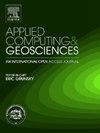Comparison of ETAS parameter estimates across different time windows within the North and East Anatolian Fault Zones, Turkey
IF 3.2
Q2 COMPUTER SCIENCE, INTERDISCIPLINARY APPLICATIONS
引用次数: 0
Abstract
Located at the intersection of major lithospheric plates, Turkey is characterized by significant seismic activity, particularly along the North Anatolian Fault (NAF) and East Anatolian Fault (EAF). This paper employs the Epidemic-Type Aftershock Sequence (ETAS) model, fitted using the BFGS quasi-Newton method, to study earthquake triggering processes along these faults from 1990 to 2023. Our findings show distinct temporal variations in seismicity parameters along these faults. Along the NAF, the ETAS model highlighted a lower background seismicity rate () and aftershock productivity () compared to the EAF. In contrast, the EAF exhibits lower magnitude sensitivity (), indicating that smaller earthquakes are more likely to trigger aftershocks, due to weaker dependence on mainshock magnitude. The aftershock decay rate () is notably faster in the NAF, suggesting quicker post-event stabilization. Our analysis across different time windows reveals significant non-stationarities in ETAS parameters, indicating that seismic behaviors along these faults do not strictly follow historical patterns. This temporal variability highlights the challenges in short-term seismic forecasting using historical data alone. A detailed comparison of ETAS parameters across time frames showcases the necessity for incorporating dynamic modeling approaches to improve earthquake forecasting in seismically active regions.
土耳其北安纳托利亚断裂带和东安纳托利亚断裂带不同时间窗内ETAS参数估计的比较
土耳其位于主要岩石圈板块的交汇处,地震活动频繁,特别是沿北安纳托利亚断层(NAF)和东安纳托利亚断层(EAF)。本文采用流行型余震序列(ETAS)模型,采用BFGS准牛顿方法拟合,研究了1990 - 2023年沿这些断裂的地震触发过程。我们的发现表明沿这些断层的地震活动性参数有明显的时间变化。在NAF上,ETAS模型显示背景地震活动性(μ)和余震生产力(K0)比EAF低。相比之下,东震场表现出较低的震级敏感性(α),表明由于对主震震级的依赖性较弱,较小的地震更有可能引发余震。余震衰减率(p)在NAF中明显更快,表明震后稳定更快。我们对不同时间窗的分析揭示了ETAS参数的显著非平稳性,表明沿这些断层的地震行为并不严格遵循历史模式。这种时间变异性突出了仅使用历史数据进行短期地震预报的挑战。ETAS参数跨时间框架的详细比较显示了采用动态建模方法来改进地震活跃地区地震预报的必要性。
本文章由计算机程序翻译,如有差异,请以英文原文为准。
求助全文
约1分钟内获得全文
求助全文
来源期刊

Applied Computing and Geosciences
Computer Science-General Computer Science
CiteScore
5.50
自引率
0.00%
发文量
23
审稿时长
5 weeks
 求助内容:
求助内容: 应助结果提醒方式:
应助结果提醒方式:


